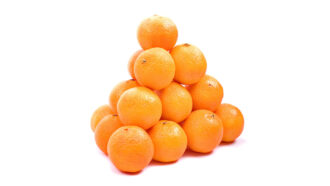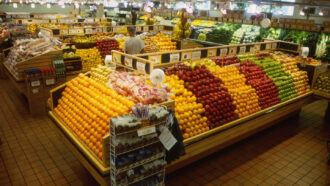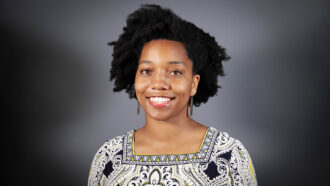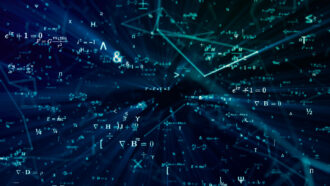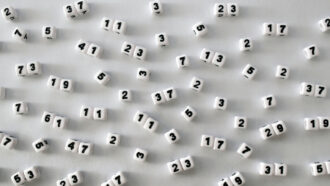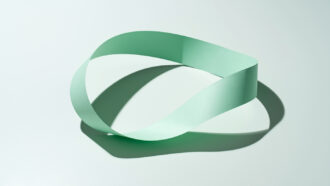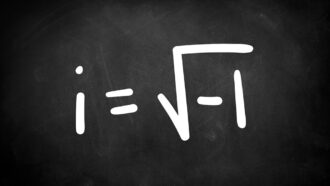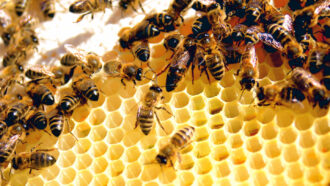It’s a math world for animals
Animal mathematicians are teaching scientists a thing or two about numbers.
By Emily Sohn
Birds do it. Dogs do it. Even salamanders do it.
The ability to solve math problems is showing up in all sorts of unlikely creatures. From monkeys who know the difference between 2 and 3 to dogs who can calculate the fastest route, animal mathematicians are teaching scientists a few things about numbers.
A growing body of research suggests that nature probably discovered math long before people did. Studies of animal mathematicians might help explain how people learn to add, subtract, and multiply and indicate what types of math people can do without going to class. Watching animals solve problems could also make math more fun for people who say they can’t stand the subject.
A fetching dog
Mathematician Tim Pennings, for instance, was at the beach when he discovered that his dog Elvis could do a type of math called calculus.
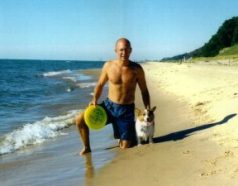 |
|
Elvis and Tim Pennings at the beach.
|
| Tim Pennings |
“I would throw a ball into the water,” Pennings says. “I noticed he’d run along the beach and then jump into the water and swim at an angle toward the ball.”
That’s a good strategy. Swimming is slow compared with running, so swimming all the way to the ball would take longer even if the route is more direct. On the other hand, running along the beach adds to the total distance Elvis must go to get to the ball. The best bet is a compromise between the two—running a certain distance along the beach before plunging into the water.
Pennings wondered if Elvis was instinctively taking the fastest possible route to the ball. First, he measured how fast Elvis runs and swims. Then, he threw a tennis ball into the water and let the little Welsh corgi go.
“I ran after Elvis with a screwdriver,” says Pennings, who works at Hope College in Holland, Michigan. “Where he turned toward the water, I drove a screwdriver into the sand. While he was swimming to the ball, I ran and grabbed a tape measure and beat him to the ball.”
Man and dog ran back and forth like this for more than 3 hours. After throwing out trials with bad tosses or high waves, Pennings had 35 sets of measurements. Then, he went home and did some calculations, using calculus to find the fastest route.
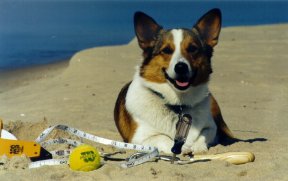 |
|
Elvis poses with the equipment used to measure how well he does his math.
|
| Tim Pennings |
“I did all the math,” Pennings says, “and I figured out that where Elvis jumps in is pretty much perfect. He kind of naturally knows the right spot to jump in.”
It took the grown man about an hour to come up with the same solution that the 3-year-old dog could figure out in a fraction of a second. But is the dog really doing the math?
“Elvis is doing calculus in the sense that he somehow knows how to find the minimum time to get to the ball,” Pennings says.
Pennings suspects that other creatures have naturally learned the most efficient ways to do things over millions of years of evolution. “There might be all sorts of things like that in nature,” he says.
One interesting follow-up study would be to do a similar experiment with people of different ages, Pennings says. Results might show an innate ability to do math that gets better or worse as people grow up and go to school.
Number sense
Studying math skills in dogs to understand math in people might not be such a far-fetched idea. In fact, some research is showing that babies and animals actually have a lot in common when it comes to numbers.
Most animal math research has focused on primates. To test whether a monkey can tell the difference between numbers of objects, scientists measure how long an animal looks at things. A monkey will look longer at something that doesn’t match what it expects to see.
Using this technique, researchers have shown that monkeys can add and subtract small numbers of objects. If they are shown one apple slice and then another, for example, they know there should be a total of two. They will then look for a longer time at a pile of three or one than at a pile of two.
Recent evidence also shows that some primates know the difference between more and less. Cotton-top tamarins look longer at two Froot Loops than at one. Rhesus macaques look longer at three turnips than at two.
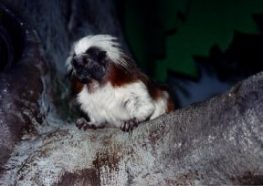 |
|
A cotton-top tamarin.
|
| Valley Zoo, Edmonton, Alberta |
Likewise, 12-month-old babies look longer at a bigger pile of sugar cookies. Even though they can’t talk or count, the babies seem to know how to go for more.
Most interesting of all, says cognitive scientist Claudia Uller, is that those skills fall apart at about the same number in both monkeys and babies.
“It’s so incredible,” says Uller, who is at the University of Louisiana at Lafayette. “It breaks down at around four. If you give babies two or three, they’ll go for three. At three versus four, their choices are random. At four versus six, they’re random.” The same is true for monkeys and tamarins.
Because primates and people are so closely related, Uller wanted to try the same experiment with a completely different kind of animal: salamanders. Amazingly, she found the same results.
When shown test tubes holding different numbers of live fruit flies, red-backed salamanders looked at the tube that held more. But only up to a certain point. Just as in babies and monkeys, the system seemed to break down around four. Uller published her results recently in the journal Animal Cognition.
Her study is the first example that an animal other than a primate might be able to distinguish between more and less. Another scientist is now looking for the same phenomenon in fruit flies, Uller says. Further research could help explain the biology behind basic math skills.
A little training
The limits of animal math are still unclear. With a little training, rats can learn to press a lever a certain number of times, say exactly 45 times, to get a reward. When shown a pile of random objects, a famous parrot named Alex can tell you how many of them are red or green. The examples go on and on.
A widespread use of math in nature makes sense, experts say, considering the challenges to survival in the wild. By recognizing which bush offers more berries, for instance, or which pack of lions is more fearsome, an animal might improve its own chances of survival. The same was probably true for our ancestors.
So, maybe math is more than just a grade on your report card. At some point, your life might depend on it!
Going Deeper:
